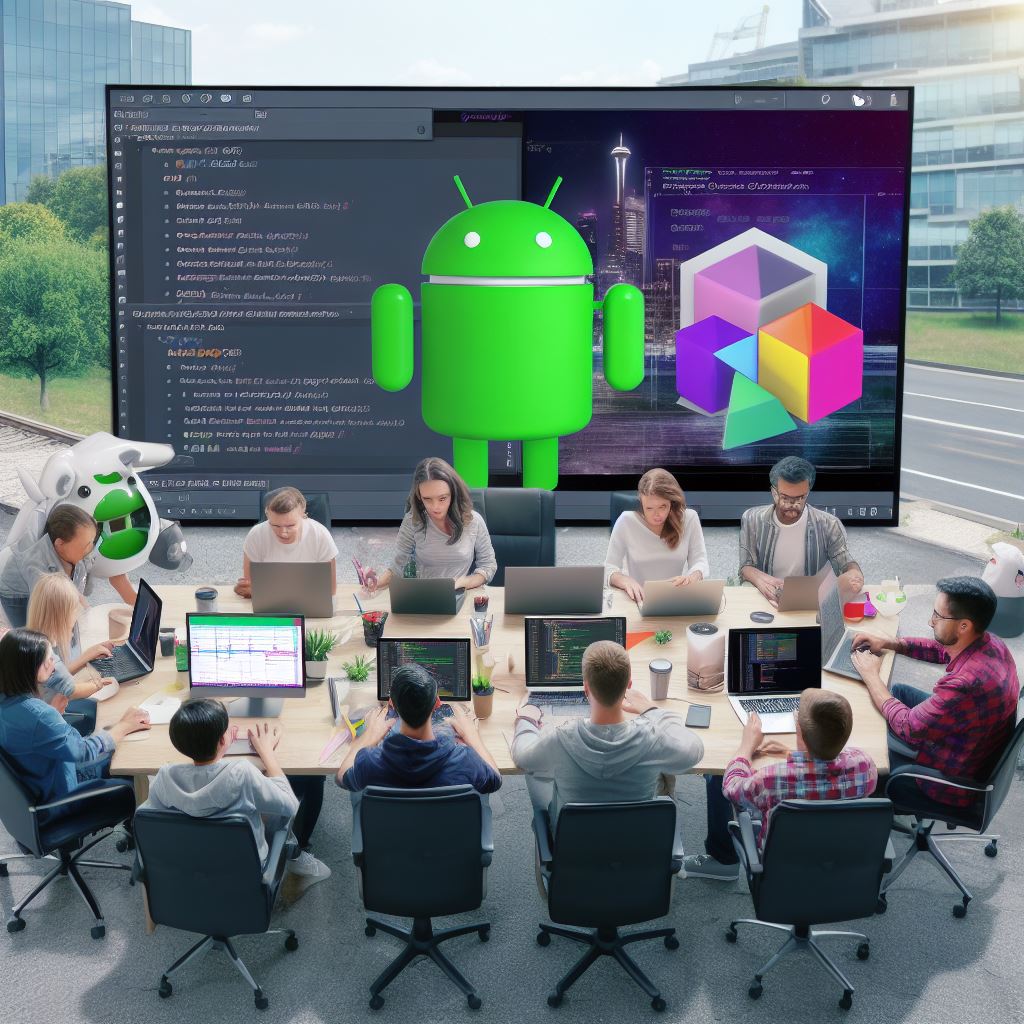Introduction
Setting up Android Studio is essential for developing Android apps.
It provides a comprehensive development environment with various tools and features.
Importance of setting up Android Studio for developing Android apps
Setting up Android Studio is crucial as it offers a complete package for Android app development.
It includes an emulator to test apps, a code editor, debugger, and supports different programming languages.
Brief explanation of Android Studio
Android Studio is the official integrated development environment (IDE) for Android app development.
It is based on IntelliJ IDEA and provides a user-friendly interface for easy development.
Android Studio offers a wide range of functionalities and features, such as code completion, importing libraries, and visual layout editor.
In general, setting up Android Studio is vital for anyone interested in developing Android apps.
Its comprehensive environment and features make it a powerful tool for beginners and professionals alike.
Installation
Setting up Android Studio for your first Android app is an important step in your app development journey.
In this section, we will guide you through the process of installing Android Studio on different operating systems, including Windows, macOS, and Linux.
Before diving into the installation process, it’s essential to check whether your system meets the necessary requirements for Android Studio.
This ensures optimal performance and functionality.
System requirements for Android Studio
To run Android Studio smoothly, your system should meet the following requirements:
- Minimum 3GB RAM, although 8GB or more is recommended
- Minimum 2GB of available disk space, with 4GB or more being preferred
- Minimum screen resolution of 1280×800
- JDK (Java Development Kit) 8 or a higher version
Once you have confirmed that your system meets these requirements, you can proceed with downloading Android Studio.
Tech Consulting Tailored to Your Coding Journey
Get expert guidance in coding with a personalized consultation. Receive unique, actionable insights delivered in 1-3 business days.
Get StartedDownloading Android Studio
To download Android Studio, follow these steps:
- Open a web browser and navigate to the official Android Studio website.
- Click on the “Download Android Studio” button.
- Choose the version suitable for your operating system (Windows, macOS, or Linux).
- Click on the “Download” button, and the download will start shortly.
After the download is complete, it’s time to move on to the installation process.
Installing Android Studio on different operating systems
1. Installing on Windows
- Locate the downloaded setup file (commonly a .exe file) and double-click on it.
- If prompted by User Account Control, click “Yes” to grant permission.
- Follow the on-screen instructions, choosing the desired installation options.
- Click “Finish” to complete the installation.
2. Installing on macOS
- Open the downloaded .dmg file by double-clicking on it.
- Drag and drop the Android Studio icon into the Applications folder.
- Open the Applications folder, locate Android Studio, and double-click on it.
- Follow the on-screen instructions to complete the installation.
3. Installing on Linux
- Extract the downloaded .zip file to a location of your choice.
- Open a terminal and navigate to the extracted folder.
- Execute the “./studio.sh” command to start the setup wizard.
- Follow the on-screen instructions, selecting the desired installation options.
- Once the installation is complete, you can launch Android Studio.
Congratulations! You have successfully installed Android Studio on your chosen operating system.
Now you can begin developing your first Android app in this powerful IDE.
In this section, we covered the necessary steps to set up Android Studio, including checking system requirements, downloading the software, and installing it on different operating systems.
Following these steps ensures a smooth setup process, enabling you to start your app development journey seamlessly.
Read: Creating 3D Coding Wallpapers with Blender Software
Setting up Android Studio
Setting up Android Studio for your first Android app involves several steps to ensure smooth development.
Here’s how to do it:
- To set up your development environment, launch Android Studio from the Start menu by clicking its icon.
- Android Studio loads and presents a welcome screen offering options to create new projects or import existing ones.
- Select “Start a new Android Studio project” to initiate the initial setup.
- The setup wizard guides you, prompting to specify project location and a meaningful name.
- Choose the devices your app will target, such as Phone and Tablet, Wear OS, TV, or Android Auto.
- Select the minimum required SDK version to ensure broad device compatibility.
- Pick an activity template for your main screen, like Empty Activity or Basic Activity.
- Provide an activity name and layout name, which can be modified as needed.
- Click “Finish” to generate project files and establish the initial structure.
- Android Studio takes you to its Integrated Development Environment (IDE) upon completion.
Before starting development, it’s important to configure your Android SDK (Software Development Kit) and JDK (Java Development Kit).
To do this:
- Go to the “File” menu and select “Project Structure” to open the project settings.
- In the project settings, navigate to the “SDK Location” section and provide the path to your Android SDK installation.
- Similarly, in the “SDK location” section, ensure the JDK location is correctly set.
- Once you’ve configured these settings, click “Apply” and then “OK” to save the changes.
- Android Studio will now be ready for you to begin coding your first Android app.
By following these steps, you have successfully set up Android Studio, configured the necessary preferences, and are ready to start building your first Android app.
Read: The Importance of Portfolio Projects for Entry-Level Coders
Creating a new project
The project structure
When creating a new project in Android Studio, it is important to understand the structure of the project.
Build Your Vision, Perfectly Tailored
Get a custom-built website or application that matches your vision and needs. Stand out from the crowd with a solution designed just for you—professional, scalable, and seamless.
Get StartedThe project consists of various files and folders, including the app module, which contains the code and resources for the application.
Selecting a template for the project (Empty Activity, Basic Activity, etc.)
Android Studio provides various templates to choose from when creating a new project.
These templates provide a basic starting point for different types of applications, such as empty activities, basic activities, and more.
Naming the project and package
After selecting a template, you need to provide a name for your project and choose a package name.
The package name is used to uniquely identify your application on the device and in the Play Store.
Choosing minimum SDK version
The minimum SDK version is the lowest version of Android that your application will support.
It is important to choose a version that covers a significant portion of the Android user base while still supporting the features you need.
Selecting other project configurations (language, form factors, etc.)
Android Studio allows you to configure various project settings, such as the programming language (Java or Kotlin) and the form factors your application will target (phones, tablets, wearables, etc.).
Read: Entry-Level Coding Jobs: Remote vs In-Person Opportunities
Familiarizing with Android Studio layout
To successfully develop your first Android app, it is essential to familiarize yourself with the layout of Android Studio.
Understanding the different components and tools available will enable you to navigate the software effectively and efficiently.
Main components of Android Studio interface
The Android Studio interface consists of several main components that are crucial for app development:
- Editor: This is where you write your code and design your app’s user interface.
- Project explorer: It displays the project hierarchy, allowing you to navigate through your app’s files and directories.
- Gradle: This is the build system for your app. It helps you manage dependencies and build your app.
- Console: It provides feedback on your code, displays error messages, and logs output.
The toolbar and navigation options
The toolbar in Android Studio contains various navigation options and tools that can greatly assist in app development:
- Run and Debug: These buttons are used to run or debug your app on either a physical device or an emulator.
- AVD Manager: It allows you to create and manage virtual devices for testing your app.
- SDK Manager: This tool helps you download and manage the Android SDK (Software Development Kit).
- Version Control: Android Studio supports version control systems such as Git, enabling you to manage your project’s code effectively.
Understanding the Project explorer and its file hierarchy
The Project explorer in Android Studio provides a hierarchical view of your app’s files and folders:
Optimize Your Profile, Get Noticed
Make your resume and LinkedIn stand out to employers with a profile that highlights your technical skills and project experience. Elevate your career with a polished and professional presence.
Get Noticed- App: This folder contains the main code and resources for your app.
- Manifests: It includes the AndroidManifest.xml file, which defines essential app information such as permissions and activities.
- Java: This folder contains Java code for your app’s functionality.
- Res: It contains resources like layouts, images, strings, and other assets used in your app’s user interface.
Additionally, Android Studio provides options to create new files or directories, rename or delete files, and manage dependencies for your app.
Familiarizing yourself with Android Studio’s layout is crucial for a smooth app development process.
Understanding how the different components and tools work together will help you navigate and utilize the software efficiently.
In the next section, we will delve into creating the basic structure of your first Android app.
Read: Which Programming Languages Are Best for Entry-Level Jobs?

Configuring virtual devices
In this section, we will focus on step 5 of setting up Android Studio for your first Android app: configuring virtual devices.
Virtual devices, also known as AVDs, are a crucial component when it comes to testing and developing Android applications.
Let’s explore the different types of virtual devices and how to create and configure them in Android Studio.
Types of virtual devices (AVDs) in Android Studio
- Phone: This type of virtual device emulates a smartphone, allowing you to test your app on various phone models.
- Tablet: If your app is designed specifically for tablets, you can choose this type of AVD to simulate tablet environments.
- Wear OS: For apps targeting wearable devices like smartwatches, this AVD type is ideal.
- TV: This type of virtual device emulates the Android TV platform, allowing you to test how your app behaves on TV screens.
- Automotive: If you are developing apps for vehicles, this AVD type simulates the Android Automotive OS.
Creating a new virtual device
- Open Android Studio and go to the AVD Manager by clicking on the AVD Manager icon in the toolbar.
- In the AVD Manager window, click on the “Create Virtual Device” button.
- Choose the category of the virtual device you want to create (Phone, Tablet, Wear OS, etc.).
- Select the hardware profile for the virtual device. You can choose from the pre-defined profiles or create a custom one.
- Next, select the system image for the AVD. System images include different Android versions and device configurations.
- Choose the version of Android you want to emulate and click “Next.”
- Configure the AVD settings such as name, screen size, launch options, and more.
- Finally, click on the “Finish” button to create the new virtual device.
Configuring AVD properties (device model, system image, screen size, etc.)
- Open the AVD Manager in Android Studio.
- Select the virtual device you want to configure and click on the “Edit” button.
- In the AVD configuration window, you can modify various properties, including device model, system image, and screen size.
- To change the device model, click on the “Hardware” section and select a different device from the list.
- To change the system image, click on the “System Image” section and choose a different Android version or API level.
- You can also modify other settings like screen size, resolution, RAM size, and more according to your testing requirements.
- Once you have made the necessary changes, click on the “Finish” button to save the configurations.
Configuring virtual devices is essential for ensuring your app works seamlessly across different devices and platforms.
By creating and configuring AVDs in Android Studio, you can thoroughly test your app’s compatibility and user experience before deploying it on actual devices.
This step allows you to identify and fix any issues early in the development process.
To summarize, configuring virtual devices involves understanding the types of AVDs available, creating new virtual devices, and configuring their properties.
With Android Studio’s powerful AVD Manager, you can confidently test your Android app’s functionality on various virtual devices, ensuring a smooth user experience for all your potential users.
Running and testing the app
Different run options (running on physical device, running on an emulator)
Before running your app, you have two options for testing it – running it on a physical Android device or running it on an emulator.
Both options have their advantages and disadvantages.
If you prefer running the app on a physical device:
- Connect your Android device to your computer using a USB cable.
- In Android Studio, click on the “Run” menu, and then select “Run app” or press Shift + F10.
- Select your connected device from the “Choose Device” window.
- Click “OK” to install and run the app on your physical device.
If you choose to run the app on an emulator:
- In Android Studio, click on the “Run” menu, and then select “Run app” or press Shift + F10.
- Select “Create New Virtual Device” to set up a new emulator.
- Select the device you want to emulate and click “Next”.
- Choose a system image for the emulator, and then click “Next” to finish setting up the emulator.
- Click “OK” to install and run the app on the emulator.
Running the app for the first time
Once you’ve selected your preferred run option, Android Studio will compile your app and install it on the device (physical or emulator). It may take a few moments.
After the installation is complete, your app will automatically launch. You can now test it and explore its features on the chosen device.
Dealing with common issues and errors during app compilation and execution
During the app development process, you might encounter some common issues or errors.
Here are a few tips to help you resolve them:
- Gradle build issues: Make sure you have the correct dependencies and plugins in your project’s build.gradle file.
- Manifest errors: Check your AndroidManifest.xml file for any errors or missing elements.
- Resource errors: Verify that all your resource files (layouts, strings, images) are correctly named and located in the appropriate directories.
- Runtime errors: Debug your app using log statements or breakpoints to identify and fix any logical or runtime errors.
- Device compatibility: Ensure that your app’s minimum SDK version is compatible with the device or emulator you are using.
If you encounter any other issues, refer to the official Android Studio documentation or seek help from the vast online community of Android developers.
Now that you know how to run and test your app, you’re one step closer to becoming an Android app developer.
Happy coding!
Conclusion
Setting up Android Studio for your first Android app is a simple process that can be done in a few easy steps:
- Download and install Android Studio from the official website.
- Configure the necessary SDKs for your app development.
- Create a new project in Android Studio and familiarize yourself with the layout.
- Start coding your app by adding activities, layouts, and functionality.
- Test your app using the built-in emulator or by connecting a physical device.
- Refine your app by debugging and making necessary adjustments.
- Generate a signed APK file for distribution.
It is important to note that while this guide covers the basic setup process, there is still much more to explore and learn in Android Studio.
Don’t be afraid to experiment with different features and functionalities.
Furthermore, app development is an ongoing process that requires continuous learning and practice.
As you gain more experience, you will become more proficient in coding and have a better understanding of app development concepts.
So, keep practicing, stay curious, and never stop learning. With dedication and persistence, you can create amazing Android apps using Android Studio.




